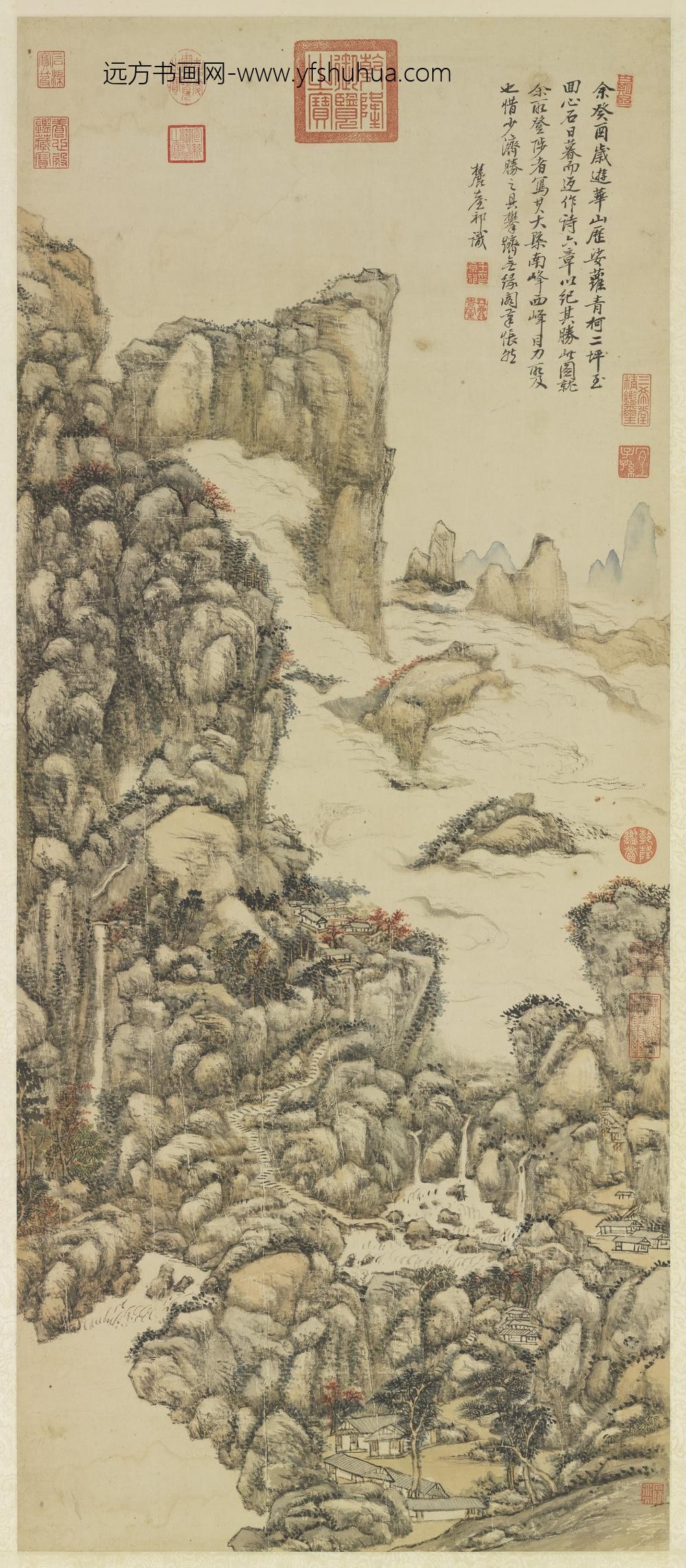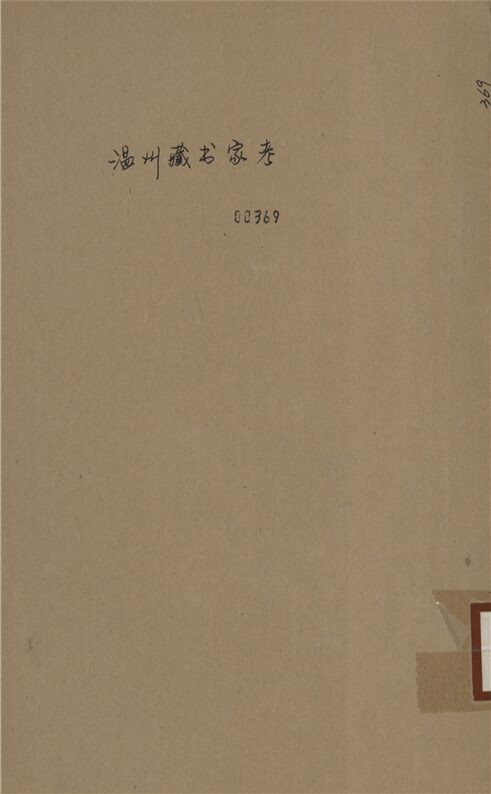【作品基本信息】
| 作者 | 王原祁 |
| 品名 | 华山秋色图轴 |
| 朝代 | 清代 |
| 文件大小 | 18.03MB |
| 分辨率(DPI) | 300×300 |
| 像素大小 | 1621×3708 |
| 尺寸(CM) | 13.72×31.39 |
| 作品数量 | 1 |
| 作品收藏 | 台北故宫博物院 |
| 图片格式 | 默认提供TIF和JPG两个版本 |
基本数据
| 藏品类型 | 绘画 |
| 品名 | 清王原祁华山秋色 轴 Autumn Colors on Mount Hua |
| 分类 | 绘画 |
| 作者 | 王原祁;Wang Yuanqi |
| 数量 | 一轴 |
典藏尺寸
| 【位置】 | 【尺寸】(公分) |
| 本幅 | 115.9×49.7 |
质地
| 【质地位置】 | 【质地】 |
| 本幅 | 纸 |
题跋数据
| 【题跋类别】 | 【作者】 | 【位置】 | 【款识】 | 【书体】 | 【全文】 |
| 作者款识 | 王原祁 | 本幅 | 余癸酉岁游华山。历娑萝青柯二坪。至回心石。日暮而返。作诗六章。以纪其胜。此图就余所登陟者。写其大槩。南峰西峰目力所及也。惜少济胜之具。攀跻无缘。阁笔怅然。麓台祁识。 | 行书 | |
| 印记: 王原祁印、麓台、古期斋、石师道人 |
|||||
印记资料
| 【印记类别】 | 【印记】 |
| 鉴藏宝玺 | 乾隆御览之宝 |
| 鉴藏宝玺 | 嘉庆御览之宝 |
| 鉴藏宝玺 | 养心殿鉴藏宝 |
| 鉴藏宝玺 | 宣统御览之宝 |
| 鉴藏宝玺 | 无逸斋精鉴玺 |
| 鉴藏宝玺 | 宣统鉴赏 |
| 鉴藏宝玺 | 乾隆鉴赏 |
| 鉴藏宝玺 | 石渠宝笈 |
| 鉴藏宝玺 | 三希堂精鉴玺 |
| 鉴藏宝玺 | 宜子孙 |
主题
| 【主题类别】 | 【主题(第一层)】 | 【主题(第二层)】 | 【主题说明】 |
| 主要主题 | 山水 | 秋景 | |
| 主要主题 | 山水 | 名胜 | 华山 |
| 其他主题 | 山水 | 云 | |
| 其他主题 | 山水 | 瀑布 | |
| 其他主题 | 建筑 | 桥 | |
| 其他主题 | 建筑 | 房舍 | |
| 其他主题 | 山水 | 溪涧、湍泉 | |
| 其他主题 | 树木 | ||
| 其他主题 | 山水 | 石磴、栈道 | 石磴 |
技法
| 【技法】 | 【技法细目】 |
| 写意 | |
| 皴法 | |
| 苔点 |
参考数据
| 【类别】 | 【参考数据】 |
| 收藏着录 | 石渠宝笈初编(养心殿),上册,页671 |
| 收藏着录 | 故宫书画录(卷五),第三册,页541 |
| 收藏着录 | 故宫书画图录,第十册,页359-360 |
| 参考书目 | 1.江兆申,〈清王原祁华山秋色〉,收入胡赛兰编,《清王原祁画山水画轴特展》(台北:国立故宫博物院,1997年初版),页134。 |
| 内容简介(中文) | 王原祁,江苏太仓人。明崇祯十五年生,清康熙五十四年卒。(公元一六四二-一七一五年)王原祁画,得之家学,而沉着茂实,出于天性。此图累石成山,而不觉细碎,盖用墨浑厚,足以总摄全体。云烟漫漶,是黑中求白,实里求虚。逐使近山益形突出,背山渐澹、渐简、渐小,而层次因之井然矣。五十二岁以后画。 |
| 内容简介(英文) | Wang Yuan-ch’i was a native of T’ai-ts’ang, Kiangsu. A grandson of Wang Shih-min (1592-1680), he is included among the four Great Wangs of the Ch’ing dynasty. In “Autumn Colors on Mount Hua”, the Mountains are composed of layers of stones, but there is no feeling of fragmentation. Wang Yuan-ch’i’s use of heavy ink enabled him to unite all parts of the painting into a total image. The diffusion of the clouds results from the interplay of light and dark, positive and negative. This interplay causes the foreground mountains to project forward, while the background mountains gradually diminish in size. Wang Yuan-ch’i painted the landscape sometime after his 51st year. |
| 内容简介(中文) | 西岳华山在今陜西省华阴县南,主峰三峰耸峙,众山拱立围绕,远望如花朵,因此得名为「华山」。华山胜景素为世人向往,明代画家曾亲临其境,而后写入画图,此幅则为清人王原祁游历归来之作。王原祁(一六四二-一七一五),字茂京,号麓台,江苏太仓人,官至户部侍郎,曾以绘画供奉内廷,画风受董其昌影响,从临摹传统开辟自己的风格。此幅传绪元人笔墨的意趣,与华山实景关联不多。 |
| 内容简介(英文) | Mount Hua (“Blossom”), Western of the 5 Sacred Peaks, is in southern Hua-ying County, modern Shensi. The main mount comprises 3 lofty peaks surrounded by lesser ones. From a distance, they look like a blossom, hence its name. The scenic wonders of Mount Hua have attracted people for ages. Ming (1368-1644) painters traveled there and recorded their experiences in art. This work by Wang Yűan-ch’i was done after a visit. A native of T’ai-ch’ang, Kiangsu, he served to Vice-minister of Revenue and often did works for the court. His style was influenced by Tung Ch’i-ch’ang’s, starting with copying the ancients. This work has more to do with Yűan (1279-1368) brushwork than actual Mount Hua scenery, which served as a vehicle for his own style. |
| 内容简介(中文) | 王原祁(1642-1715),江苏太仓人。字茂京,号麓台,王时敏之孙。继承家法,学元四家,然能自出心裁,为清初四王之一。 此幅为画家游历华山归来之作。画中垒石成山,而不觉细碎,盖用墨浑厚,足以总摄全体。云烟迷漫,是黑中求白,实里求虚。遂使近山益形突出,背山渐淡、渐简、渐小,因之层次井然。全图重在笔情墨趣,与华山实景并无关联。从画风看来,应为王氏五十二岁以后所画。 (20110913) |
| 内容简介(英文) | Wang Yuanqi (style name Maojing, sobriquet Lutai) was a native of Taicang in Jiangsu and the grandson of Wang Shimin. Following in the family tradition, he studied the styles of the Four Yuan Masters but also was able to give play to his natural talents, becoming known as one of the Four Wangs of the Early Qing. This painting, done after the artist had visited Mount Hua, reveals overlapping rocks that form mountains but do not appear scattered. The use of ink is simple and straightforward, sufficient to unite all the parts into a total form. The clouds and mists are hazy, resulting from the suggestion of light in the dark and void within the solid. This interplay causes the foreground mountains to project forward and the background mountains to gradually diminish in size. The painting throughout focuses on the artist’s interest in the use of brush and ink, being unrelated to the actual appearance of Mount Hua itself. Judging from the style, it was probably done by Wang after the age of 52. (20110913) |
【作品展示】





